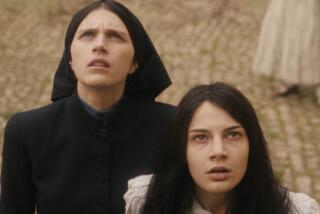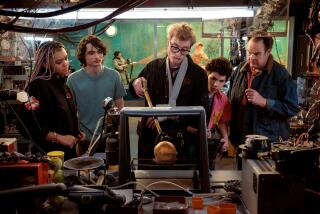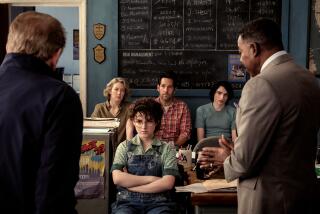Review: Hello, dolly! ‘Annabelle: Creation’ is a creaky, crafty origin story
In the opening moments of “Annabelle: Creation,” a ruthlessly efficient jolt delivery machine, we learn that the rosy-cheeked demon doll known as Annabelle was one of 100 limited-edition toys fashioned during the 1940s. This news may trigger a moment’s disbelief — even before the Cabbage Patch Kids, was there really that much demand for something that looks like the love child of Pippi Longstocking and Baby Jane? — followed by a shudder at the havoc likely being wreaked by the 99 other Annabelles, each of which might well be the star of her own grisly spinoff.
It’s not the least plausible idea, given the global popularity of “The Conjuring” (in which Annabelle first reared her wooden head) and its various follow-ups, as well as the endlessly self-perpetuating “cinematic universe” mentality that governs studio movie production these days. Still, after 2014’s cheaply effective “Annabelle” and now this creaky but superior origin story, it’s probably best if the filmmakers lay the whole hell-puppet mythology to rest — for a while, at least. As these movies demonstrate ad nauseam, Annabelle doesn’t like to stay on her shelf for too long.
Written by returning “Annabelle” screenwriter Gary Dauberman, the new film opens with the doll being lovingly assembled and painted by Samuel Mullins (Anthony LaPaglia), a toymaker who lives with his wife, Esther (Miranda Otto), and their young daughter, Bee (Samara Lee), in a large clapboard house in a remote stretch of Southern California desert. Creation swiftly begets destruction: In a shock scene that feels imported from an altogether cruder movie, tragedy strikes, leaving Samuel and Esther stricken with grief.
Twelve years later, the couple open their doors to six orphan girls and their caretaker, Sister Charlotte (Stephanie Sigman), who are initially thrilled to have such an enormous, lavishly appointed new home to call their own. It’s a choice that immediately distinguishes the movie from “Annabelle,” with its middle-class L.A. milieu, and establishes a sense of continuity with “The Conjuring” and “The Conjuring 2,” both of which told stories subtly rooted in economic despair, about young women in ramshackle homes that quickly came to feel like prisons.
The girl experiencing most of the haunting here is Janice (the effortlessly sympathetic Talitha Bateman), who is unsurprisingly the most vulnerable and alienated orphan of the group, having been stricken with polio. Forced to wear a leg brace and later confined to a wheelchair, Janice seeks comfort amid the forbidden relics of Bee’s old bedroom: an enormous dollhouse, a puppet theater and, of course, the dreaded Annabelle herself. The doll is often shown seated in near-total darkness, with just enough ominous backlighting to illuminate those creepy pigtails and that dead, malevolent stare.
As someone helpfully explains ... [Annabelle] is Satan’s conduit rather than his walking, talking handmaiden. (Either way, she’s not an ideal houseguest.)
Unlike Chucky or, say, the clown doll in “Poltergeist,” Annabelle is never seen moving of her own accord; as someone helpfully explains at one point, she is Satan’s conduit rather than his walking, talking handmaiden. (Either way, she’s not exactly an ideal houseguest.) That she remains inanimate and immobilized may seem a restriction at first, but it’s one that the Swedish-born director David F. Sandberg, fresh off his solid debut with last year’s horror-thriller “Lights Out,” succeeds in turning ingeniously to his advantage.
The result may not be much more than an exercise in craft, a skillful demonstration of all the games you can play with long takes, moving cameras, blurred focus and cavernous pools of darkness. But craft is hard to overrate these days, and Sandberg’s technique, far from feeling assaultive or bludgeoning, has the effect of heightening your concentration. When you find yourself anxiously scanning every background for suspicious activity, or wondering how a house full of people can suddenly seem so ominously quiet and emptied-out, you know the filmmaker knows what he’s doing.
A richer script might have allowed Sandberg to engage more meaningfully with his characters — who, apart from the Mullinses (played with quiet gravity by Australian actors LaPaglia and Otto) and Janice’s plucky friend Linda (Lulu Wilson), are a fairly nondescript bunch. The older girls roll their eyes at the younger ones and giggle knowingly about boys, but the movie isn’t especially interested in the competitive dynamics or deeper anxieties of female adolescence. Nor, despite Sigman’s fervent Sister Charlotte and a few half-heartedly wielded crucifixes, does it evince much of the spiritual interest or rigor that might nudge it anywhere near the grand tradition of classic demonic-possession movies like “The Exorcist.”
In the end, “Annabelle: Creation” seems most invested in mechanics and minutiae: It’s fascinated by the squirm-inducing possibilities of a malfunctioning dumbwaiter, or a none-too-reliable chair lift that Janice has to use to get up and down the stairs. It’s keen too on making sure the events of this prequel and the original “Annabelle” snap together as neatly as possible — too neatly, perhaps. By the end, you are reminded that the franchise model is seldom an ideal fit for the horror genre, not least because of the unavoidable suggestion that Satan is operating on some sort of yearly installment plan.
It has become common, under these circumstances, to instruct the audience to stay past the closing credits, but this is one case where I might actually advise the opposite. Some things are scarier when you can’t see them coming, sequels included.
------------
‘Annabelle: Creation’
Rating: R, for horror violence and terror
Running time: 1 hour, 49 minutes
Playing: In general release
Movie Trailers
justin.chang@latimes.com | Twitter: @JustinCChang
More to Read
Only good movies
Get the Indie Focus newsletter, Mark Olsen's weekly guide to the world of cinema.
You may occasionally receive promotional content from the Los Angeles Times.







